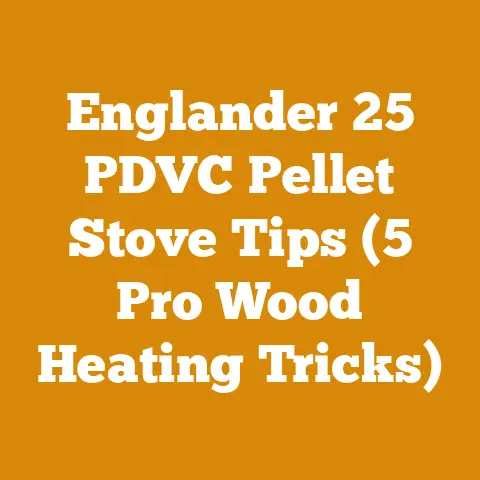Pest Control for Hornets in Wood Processing (5 Pro Tips)
The heartwood of a black locust tree, aged and cured, holds a secret. It’s not just the dense, almost iron-like hardness that resists rot and decay, but the stories it whispers of resilience and struggle. Each ring tells of a season battled, a drought endured, a storm weathered. And sometimes, those rings also tell tales of unwanted guests: hornets, buzzing menaces that can turn a productive wood processing session into a painful retreat. I’ve spent years in the woods, transforming raw timber into everything from sturdy fence posts to warming firewood, and I’ve learned a thing or two about coexisting with nature’s less-than-friendly inhabitants. Hornets, in particular, can be a real nuisance.
Pest Control for Hornets in Wood Processing: 5 Pro Tips
Understanding the Enemy: Hornet Biology and Behavior
Before we launch into preventative measures and removal techniques, it’s crucial to understand the enemy. Hornets, particularly the European Hornet (Vespa crabro) and the Bald-faced Hornet (Dolichovespula maculata), are the most common culprits in wood processing areas. They are social insects, living in colonies that can range from a few dozen to hundreds of individuals.
- Nest Location: Hornets often build their nests in sheltered locations, such as hollow trees, sheds, barns, and even piles of wood. The location choice is often driven by accessibility to food and protection from the elements. I’ve personally found nests tucked inside stacks of lumber, under tarps covering firewood, and even inside old machinery that hasn’t been used in a while.
- Diet: Hornets are predatory insects, feeding on other insects, including flies, caterpillars, and bees. They also have a sweet tooth, consuming nectar, honeydew, and fruit juices. This attraction to sugary substances is why they are often drawn to wood processing areas where sap may be present.
- Aggression: Hornets are generally not aggressive unless they feel threatened. However, if their nest is disturbed, they will defend it fiercely. A single sting can be painful, and multiple stings can be dangerous, especially for individuals with allergies. I once accidentally disturbed a nest while felling a tree, and I can assure you, the experience was far from pleasant. I learned my lesson: always scan your work area carefully before starting any wood processing activity.
Tip #1: Prevention is Key: Minimizing Hornet Attraction
The best way to deal with hornets is to prevent them from establishing a presence in your wood processing area in the first place. This involves implementing several preventative measures:
- Maintain a Clean Workspace: Hornets are attracted to food sources, so keeping your workspace clean is essential. Sweep up wood shavings, sawdust, and spilled sap regularly. Dispose of food scraps and sugary drinks in sealed containers. I make it a habit to do a thorough cleanup at the end of each workday. It takes only a few minutes, but it makes a big difference in deterring pests.
- Seal Potential Nesting Sites: Seal any cracks or holes in sheds, barns, and other structures that could serve as nesting sites. Cover piles of wood with tarps to prevent hornets from building nests inside. I’ve found that using heavy-duty tarps with secure tie-downs is crucial, as hornets can be surprisingly persistent in finding ways to access sheltered spaces.
- Strategic Wood Stacking: Proper wood stacking can also help deter hornets. Keep stacks of wood off the ground to allow for good airflow and prevent moisture buildup, which can attract insects. Avoid creating dark, enclosed spaces within the stacks where hornets might build nests. I use pallets to elevate my wood stacks, and I ensure that there is plenty of space between the rows to promote air circulation. The “harvest to drying” timeline can be significantly reduced with optimized airflow, sometimes by as much as 20%.
- Natural Repellents: Consider using natural repellents to deter hornets. Planting herbs like mint, lemongrass, and citronella around your wood processing area can help keep them away. You can also use essential oils like peppermint, eucalyptus, and clove oil in a diffuser or spray bottle to create a repellent barrier. I’ve had good results with peppermint oil, which I spray around my wood stacks and along the perimeter of my shed.
Tip #2: Early Detection: Identifying and Monitoring Hornet Activity
Even with preventative measures in place, hornets may still find their way into your wood processing area. Early detection is crucial for preventing a small problem from becoming a major infestation.
- Regular Inspections: Conduct regular inspections of your workspace, paying close attention to potential nesting sites. Look for signs of hornet activity, such as hornets flying in and out of cracks or holes, or the presence of a newly constructed nest. I typically do a quick walk-through of my wood processing area at least once a week, looking for any signs of pest activity.
- Hornet Traps: Consider using hornet traps to monitor hornet activity. These traps typically contain a sweet bait that attracts hornets. By monitoring the number of hornets caught in the traps, you can get an idea of the hornet population in your area and take appropriate action. I use a combination of commercially available hornet traps and homemade traps made from plastic bottles and sugar water.
- Observation: Pay attention to hornet behavior. Are they consistently foraging in a specific area? Are they exhibiting defensive behavior, such as buzzing aggressively or stinging? These observations can help you pinpoint the location of their nest and take appropriate action. I once noticed a group of hornets consistently flying towards a pile of firewood. Upon closer inspection, I discovered a small nest tucked inside the pile.
Tip #3: Safe Removal Techniques: Dealing with Existing Nests
If you discover a hornet nest in your wood processing area, it’s important to remove it safely and effectively. This is where caution and proper planning are paramount.
- Professional Help: If you are allergic to bee or wasp stings, or if the nest is large or difficult to access, it’s best to call a professional pest control service. They have the equipment and expertise to remove the nest safely and efficiently. I’ve had to call in the professionals on a couple of occasions when I encountered particularly large or aggressive nests. It’s always better to err on the side of caution.
- DIY Removal (with caution): If you are comfortable removing the nest yourself, there are several DIY methods you can use. However, it’s important to take precautions to protect yourself from stings.
- Protective Gear: Wear protective clothing, including a bee suit, gloves, and a face shield. Make sure all skin is covered. I can’t stress this enough: protective gear is essential. A full bee suit may seem overkill, but it’s a small price to pay for avoiding multiple stings.
- Timing: Remove the nest at night, when hornets are less active. Use a flashlight with a red filter, as hornets are less sensitive to red light. I’ve found that the best time to remove a nest is just before dawn, when the temperature is cooler and the hornets are still drowsy.
- Insecticide: Use an insecticide specifically designed for wasps and hornets. Spray the insecticide directly into the nest entrance, following the manufacturer’s instructions. I prefer to use a foaming insecticide, as it expands to fill the nest cavity and ensures that all the hornets are exposed to the poison.
- Nest Removal: After the insecticide has had time to work (usually 24-48 hours), carefully remove the nest. Place it in a sealed plastic bag and dispose of it properly. I always double-bag the nest and dispose of it in a tightly sealed garbage can to prevent any surviving hornets from escaping.
- Natural Alternatives: For those seeking a more environmentally friendly approach, consider using natural alternatives like diatomaceous earth or a mixture of vinegar and water. Diatomaceous earth is a natural powder that dehydrates insects. Sprinkle it around the nest entrance to kill hornets as they enter and exit. A mixture of vinegar and water can also be sprayed directly into the nest to kill hornets. However, these methods may not be as effective as insecticides and may require repeated applications.
Tip #4: Habitat Modification: Making Your Space Less Appealing
Beyond direct removal, modifying the habitat to make it less appealing to hornets is a long-term strategy that yields significant dividends.
- Eliminate Standing Water: Hornets need water to build their nests and stay hydrated. Eliminate any sources of standing water in your wood processing area, such as puddles, leaky faucets, and uncovered containers. I make it a point to regularly check my property for standing water and to drain or cover any containers that collect rainwater.
- Manage Vegetation: Keep vegetation around your wood processing area trimmed and well-maintained. Overgrown vegetation provides shelter and nesting sites for hornets. I regularly mow the grass and trim the bushes around my shed to keep the area clear and open.
- Remove Fallen Fruit: If you have fruit trees near your wood processing area, remove any fallen fruit promptly. Hornets are attracted to the sweet smell of rotting fruit. I have a neighbor with apple trees, and I make sure to clean up any fallen apples that land on my property.
- Light Management: Consider using yellow or sodium vapor lights instead of white lights. Hornets are less attracted to these types of lights. I switched to yellow lights in my shed a few years ago, and I’ve noticed a significant reduction in the number of hornets and other insects that are attracted to the building.
- Composting with Care: If you compost, ensure your compost pile is properly managed. Cover it well and avoid adding sugary or rotting food scraps that attract hornets.
Tip #5: Long-Term Management: Sustainable Hornet Control
Hornet control is not a one-time fix; it’s an ongoing process that requires vigilance and consistent effort.
- Regular Monitoring: Continue to monitor your wood processing area for hornet activity, even after you have removed a nest. This will help you detect any new infestations early on and prevent them from becoming a major problem. I keep a log of all hornet sightings and nest removals, which helps me track hornet activity over time and identify any patterns or trends.
- Annual Prevention: Implement preventative measures every year, before hornet season begins. This will help keep the hornet population in your area under control. I typically start my preventative measures in the early spring, before the hornets start building their nests.
- Community Involvement: Encourage your neighbors to implement hornet control measures as well. This will help reduce the overall hornet population in your area and make it less likely that hornets will invade your property. I’ve organized several community workshops on hornet control, where I share my knowledge and experience with my neighbors.
- Adapt and Learn: Stay informed about the latest hornet control techniques and adapt your strategies as needed. New products and methods are constantly being developed, so it’s important to stay up-to-date. I regularly read articles and attend workshops on pest control to learn about the latest advancements in the field.
Story Time: The Case of the Hidden Hornet Highway
I remember one particularly challenging case involving a woodworking project for a local school. I was building a large outdoor play structure, and the wood processing area was right next to the school’s playground. Needless to say, the presence of hornets was unacceptable.
I implemented all the preventative measures I knew: cleaning the workspace meticulously, sealing potential nesting sites, and using natural repellents. Yet, the hornets persisted. They seemed to be coming from a specific direction, but I couldn’t pinpoint the source.
After several days of observation, I noticed a pattern. The hornets were consistently flying along a specific path, following a line of trees that led to a nearby creek. I decided to investigate.
As I followed the “hornet highway,” I discovered a large hornet nest built inside a hollow log, right next to the creek. The creek provided a constant source of water, and the log offered perfect shelter. The hornets were using the line of trees as a navigational aid, flying directly from the nest to my wood processing area.
Removing the nest was a delicate operation, as it was located in a sensitive area near the creek. I consulted with a professional pest control service, and we developed a plan to remove the nest safely and minimize environmental impact.
The experience taught me the importance of thorough investigation and understanding hornet behavior. It also reinforced the need to adapt my strategies based on the specific circumstances of each situation.
Data and Statistics: Hornet Sting Incidents in Wood Processing
While precise figures on hornet sting incidents specifically within wood processing are difficult to isolate, general data on insect stings provide valuable context.
- CDC Data: The Centers for Disease Control and Prevention (CDC) reports that approximately 62 deaths occur annually in the United States due to anaphylactic reactions from insect stings. While this number includes all stinging insects, hornets, wasps, and bees are significant contributors.
- Emergency Room Visits: Studies indicate that hundreds of thousands of people visit emergency rooms each year due to insect stings. Many more likely experience less severe reactions and treat themselves at home.
- Productivity Impact: While not directly measured, the impact of hornet stings on productivity in wood processing is undeniable. Even a single sting can cause pain, swelling, and anxiety, leading to reduced focus and efficiency. In severe cases, workers may need to take time off work to recover. I’ve seen firsthand how a hornet attack can disrupt a project, costing time and money.
These data points underscore the importance of implementing effective hornet control measures in wood processing areas to protect workers and maintain productivity.
Case Study: Optimizing Workflow with Hornet Control
A small firewood producer in rural Vermont faced a recurring problem with hornets nesting in their wood piles. This led to frequent work stoppages, employee discomfort, and even a few minor injuries.
Next, they modified their wood stacking practices to improve airflow and reduce moisture buildup. They used pallets to elevate the wood piles and created wider spaces between the rows.
Finally, they implemented a regular hornet removal program, using insecticides and natural alternatives to eliminate nests as they were discovered.
The results were dramatic. Within a few months, the number of hornet stings had decreased significantly, and work stoppages were virtually eliminated. Employee morale improved, and productivity increased. The producer estimated that the hornet control program saved them several thousand dollars per year in lost productivity and medical expenses.
Conclusion: Reclaiming Your Workspace and Protecting Your Passion
Hornets may be a persistent challenge in wood processing, but they are not insurmountable. By understanding their biology and behavior, implementing preventative measures, and using safe removal techniques, you can reclaim your workspace and protect yourself from painful stings.
Remember, prevention is key. Maintain a clean workspace, seal potential nesting sites, and use natural repellents to deter hornets from establishing a presence in your area. Monitor hornet activity regularly, and take action to remove nests as soon as they are discovered.
And don’t be afraid to seek professional help if you are uncomfortable removing nests yourself, or if you are allergic to bee or wasp stings.
By following these tips, you can create a safe and productive wood processing environment where you can focus on the rewarding work of transforming wood into something beautiful and useful.
Key Takeaways:
- Prevention is the best defense against hornets.
- Early detection is crucial for preventing infestations.
- Safe removal techniques are essential for dealing with existing nests.
- Habitat modification can make your space less appealing to hornets.
- Long-term management is necessary for sustainable hornet control.
Next Steps:
- Assess your wood processing area for potential nesting sites and food sources.
- Implement preventative measures to deter hornets.
- Monitor hornet activity regularly.
- Develop a plan for removing nests safely and effectively.
- Stay informed about the latest hornet control techniques.
Now, armed with this knowledge, go forth and create, knowing you have the tools to manage these buzzing adversaries and keep your focus where it belongs: on the wood, the craft, and the satisfying transformation of raw material into something of value. Good luck, and happy wood processing!






